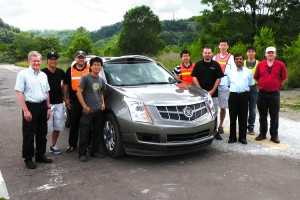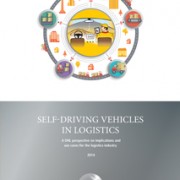Posts
Ford hires big data expert to study how drivers drive, improve autonomous services
/0 Comments/in Consumer, Future, Industry, News, TechnologyInternational Business Times
U.S. Navy tests autonomous submarine, called ‘GhostSwimmer’
/0 Comments/in Economics, Future, Impact, Industry, News, Technology, TransportationEngineering.com
A Millennial’s Perspective on Driverless
/0 Comments/in Article, Future, Impact, Technology, TransportationSteve Feyer
For most of our adult lives, the millennial generation has been hearing about the promise of driverless cars. While other technology changes took place behind a screen, this revolution promises to change our lives in the real world.
This revolution promises to have a great impact on the lives of those under the age of 35, yet most commentary focuses on the opinions of political leaders, business people, and researchers who are much older. How do young adults view the coming of driverless cars?
In this series of two articles, Driverless Transportation interviewed Americans under the age of 35 about their opinions on driverless cars, seeking to understand how they hoped to benefit, and what they thought they would lose, as this technology is deployed.
In the first installment, we spoke with ten millennials working in the autonomous vehicle field. The panel included scientists, public policy experts, and engineers educated at top programs such as Carnegie Mellon University, Stanford and MIT. Interviewees included current students, entrepreneurs, researchers, and professors.
The majority of those interviewed said they still see fully driverless cars as far off. More than half thought the technology will not appear on roadways until 2030 or later. Only one thought a NHTSA Level 4 vehicle would appear in as little as six years.
Yet Google unveiled such a prototype just this past summer, so why the skepticism?
“One of the major reasons is the lack of trust in the technology,” said a current Carnegie Mellon computer science student. “Right now, some people still believe that they can make a better decision than a computer or driverless car can, despite some pretty overwhelming statistics [to the contrary].”
With their deep knowledge of the technology involved, some doubted the promise of totally automated driving.
“I don’t know if we’ll ever get to a point where a car can work its way out of any situation,” said one policy expert.
Another expert commented, “I do not think I can afford a driverless car in Level 4 in my life.”
Much coverage of driverless car technology focuses on the possibilities, but the most informed are more focused on the difficulty of engineering a car that can handle the full range of driving situations. Given this challenge, the panelists expressed more confidence in lower levels of automation for more routine driving tasks, such as auto valet and highway autopilot.
Although Google is best known for bringing driverless cars into the public eye, perhaps surprisingly, only one of these young experts thought Google would be the first to bring a driverless car to market.
“Despite the excitement over the Google car, they are not going to be the ones who sell you one of these things,” one inventor declared confidently. “Their goal is to push other companies to this market faster.”
Most thought the incumbent automakers would win the race to autonomy, specifically pointing to the German automakers and suppliers as the innovators.
“The German companies have been in this area for longer and, in my opinion, currently have the superior solutions,” said one young researcher.
Nissan and Tesla also received several votes of confidence, Nissan because of its aggressive public statements and Tesla for its level of inventiveness in a short history.
“Nissan/Infiniti seems to be making a larger bet than most on the technology,” said an engineer who builds autonomous vehicles. “Tesla and Google will definitely factor in, but I don’t know if they have the leverage to affect the majority of the auto market.”
No matter which companies are first, the technology still faces a formidable range of challenges. When prompted to discuss the main barrier to fully driverless cars, each expert talked about a different problem. The concerns fell into three general categories: technology, consumer trust and liability.
A host of unsolved technology problems occupy the experts. “Will standards be determined by a government entity or will it be an industry consortium?” asked one entrepreneur. An engineer commented on the stubbornly high cost of effective sensors. Another company founder wondered how current map-based approaches could be cost-effective: “Can they afford to test with professional drivers for all those vehicle miles traveled until they certify each software change?”
Despite the extraordinary advances of recent years, the consensus appears to be that the technology must pass many more hurdles to be ready for the mass market.
Other comments focused on consumer perception of driverless cars, with one engineer flatly declaring that most drivers will never allow their cars to take over for them.
A policy researcher asked an important question about maintenance: “On just about every corner in the U.S. you can find a mechanic who will change your oil. But how many people will be qualified to make sure the software is up-to-date and running correctly?”
Several interviewees mentioned the issue of liability, perceiving that driverless cars threaten the insurance industry’s existing business models. An engineering masters student illustrated the problem: “At the announcement of Google’s driverless car, Warren Buffett said this is the one of the worst things to affect the American economy. He happens to own a major share in Geico and he knows this would be a hit to the insurance industry.” Most who spoke about this concern, however, declared it solvable in time.
Once the issues with technology and marketing are addressed, driverless cars will raise other challenges that these young leaders hope to address. Several interviewees went into detail about traffic and access to transportation.
Avi Mersky, a Carnegie Mellon PhD student, is troubled by the potential impact on mass transit and road usage.
“Even if society subsidizes personal autonomous vehicle usage, such that all can afford it, the efficiency loss in terms of space needed for transportation and energy usage can be expected to be quite large,” Mersky explained. “If society doesn’t provide such subsidies, then much of society could find its access to transport greatly degraded. This would lead to severe costs, not just on individuals, but society as a whole.”
More optimistically, a different policy researcher suggested that “a mobility-on-demand system can make taxi systems cheaper and more efficient, and can be used to address the first and last mile problem that can make public transportation so much more tedious.”
Some published estimates have suggested a fleet of fully driverless cars could be 90 percent smaller, in theory lessening congestion, but those who are closest to the problem are not confident in this prediction.
“There’s the very real possibility that autonomous vehicles will only make traffic and congestion worse,” the policy researcher continued. “The media focuses on the hype that autonomous vehicles are going to solve all our traffic problems.”
The panelists suggested three factors that could cause driverless cars to worsen congestion. Vehicles could be programmed to be so conservative that they increase following distance and stopping times. A lack of V2V communication standards could cause vehicles not to coordinate with each other. Finally, if the cost of time spent in the car is lower, people may choose to spend much more time in vehicles – perhaps even living out of them in great numbers.
Concluded one professor, driverless cars “will change the way people commute and travel, change people’s daily schedule and life style, and our traffic in the next few decades will look very different from today.”
Whether this change is a boon remains to be seen.
While they work on different facets of driverless transportation, these rising leaders have suggested that traffic management is the most uncertain and difficult problem. The driverless future may not materialize unless autonomous cars are more convenient than today’s cars.
One could conclude from these interesting conversations that the twin issues of transit and congestion urgently need the energy and insight of the next wave of emerging world-changers.
Our young leaders had much more to say. In our second installment about the millennial view of driverless cars, we will compare the thoughts of these innovators with the opinions of twenty-somethings who work outside the field.
 Steve Feyer is a James R. Swartz Entrepreneurial Fellow and MBA at Carnegie Mellon University’s Tepper School of Business.
Steve Feyer is a James R. Swartz Entrepreneurial Fellow and MBA at Carnegie Mellon University’s Tepper School of Business.
DHL Report on Self-Driving Vehicles
/0 Comments/in Article, Future, Impact, Industry, Insurance, Legal, Technology, TransportationLast week, international logistics company DHL released a report entitled “Self-Driving Vehicles in Logistics.” The report provides a comprehensive overview of the current state of the driverless transportation industry. It gives a good, high-level overview of the current state of the technology and its legal issues, as well as perceived consumer acceptance. (We here at Driverless Transportation aren’t sure there is much value in consumer surveys at this point.) It then gives a good rundown, by manufacturer, on the current state of the art in autonomous capabilities.
The core of the report, of course, was the implications of driverless technology on logistics. Here it goes through the logistics process from the initial warehouse through delivery to the end customer. They do make a compelling case about how driverless technology is more likely to impact logistics than passenger vehicles in the short term.
Click here for the full report. It is worth checking out.
DHL: Self-Driving Vehicles in Logistics
/0 Comments/in Future, Impact, Reports & Books, TransportationDHL
This trend report examines the distance that needs to be covered before self-driving technology reaches full maturity, and addresses the challenges of regulations, public acceptance, and issues of liability. It also shines the headlights on various best-practice applications across several industries today, and takes a detailed look into the existing technology that’s successfully used today as well as some future applications for self-driving vehicles in the logistics industry.


